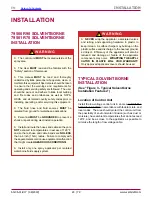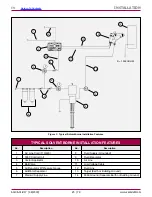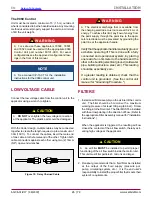
WA R N I N G
!
CAUTION
!
WA R N I N G
!
CAUTION
!
For efficient electrostatic operation, keep the applicator’s
exterior and low voltage cable free of paint accumulation.
This prevents the loss of voltage to ground with a resultant
reduction in transfer efficiency. Paint accumulation in and
around the air cap nozzles will reduce atomization quality.
Clean the air cap using clean solvent and a soft bristle brush
as often as needed to ensure good atomization.
Proceed as follows:
1. Turn OFF the control unit power.
2. Release the trigger.
3. Turn the paint flow OFF.
4. See "Applicator Repair - Disassembly Procedures"
in the "Maintenance" section.
When installing or removing the fluid nozzle, the
applicator
MUST
be triggered. Failure to do so may
cause damage to the electrode or fluid nozzle. Such
damage can result in fluid leaks around the sealing
area of these components.
Using any tool other than the Ransburg multi-
purpose wrench (19749-00) to remove or install the
fluid nozzle may cause damage.
NEVER
wrap the applicator, associated valves
and tubing, and supporting hardware in plastic to keep
it clean. A surface charge may build up on the plastic
surface and discharge to the nearest grounded object.
Efficiency of the applicator will also be reduced and
damage or failure of the applicator components may
occur.
WRAPPING THE APPLICATOR IN PLASTIC
WILL VOID WARRANTY.
Only approved applicator
covers should be used.
Any broken or damaged components should be
replaced. Any damage to the applicator may result in
UNSAFE
operating conditions.
5. Clean the applicator and associated parts with a soft
brush and suitable solvent.
Metal tools and wire brushes must
NEVER
be
used.
NEVER
use a cleaning tool that is harder than
the plastic parts. If a deposit cannot be removed with
the solvent and a rag or the soft brush, soak
ONLY
the
part in the solvent until the deposit can be removed!
NEVER
soak the applicator body or barrel!
WA R N I N G
!
WA R N I N G
!
FLUSHING PROCEDURES
1. Turn OFF the control unit power.
Whenever solvent is flushed through the applicator
the control unit power must be off.
2. Turn the paint supply OFF.
3. Turn the atomizing air supply OFF.
4. Tilt the applicator down and trigger until it is clear
of paint.
5. Connect the solvent supply.
6. Run solvent through the system until it runs clear.
Any solvent used to clean the fluid passages
must be discharged into a grounded container. Use
of ungrounded or plastic containers may cause fire
or explosion.
7. Disconnect the solvent supply.
8. Trigger the applicator until it is clear of solvent. After the
preceding steps are complete, the applicator is ready
for color change, storage, or maintenance.
CAUTION
!
DO NOT
allow the fluid lines to stand empty
without flushing first! This will cause dried paint
flaking and clogging of the fluid lines, applicator
passages, and/or nozzles.
AH-06-01-R17 (08/2019)
38 / 79
www.carlisleft.com
MAINTENANCE
EN
















































